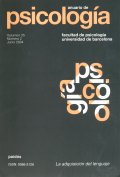Diferencias individuales en el desarrollo gramatical inicial: aportaciones del estudio de los niños ciegos
Paraules clau:
Early gramatical development, individual dzferences, blind children's language, language learning styles.Resum
Previous studies suggested that blind children tend to use a Gestalt or holistic style, instead of an analytic one, in their acquisition of language. The present paper compares the first grammatical constructions produced by three children with dlfferent degrees of vision. The three children were studied longitudinally from the age of 22 to 25 months. The firstchild was a totally blind girl, the second was a visually deficient boy, and the third was a girl with normal vision. The children lived in similar bilingual Spanish-Galician contexts, and all of them were bilingual. In order to analyse the children's productions, every multi-word utterance was classified
as either a) frozen phrase, b) intermediate utterance, or c) constructed utterance, following the category system proposed by Pine and Lieven (Pine and Lieven, 1993; Lieven, Pine and Baldwin, 1997). The results show that the blind girl used a greater number offr-ozen phrases and fewer
constructed utterances than the other two children. The different developmental patterns found in the three children are considered as evidence of the existence of different styles of language learning. The features found are related to later grammar development.
Descàrregues
Publicades
2004-01-12
Número
Secció
Estudios
Llicència
El/la autor/a que publica en esta revista está de acuerdo con los términos siguientes:
El/la autor/a cede en exclusiva todos los derechos de propiedad intelectual al/la editor/a para todo el mundo y toda la duración de los derechos de propiedad intelectual vigentes aplicables.
El/la autor/a puede difundir una copia de sus artículos respetando la política de acceso libre de la revista.


